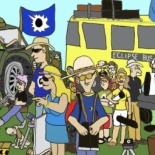
|
www.eclipse-chasers.com Gallery Report Programmer: Bill Kramer Last update: April 17 2015 |
Eclipse Chaser
(noun) - Anyone that wants to see a total solar eclipse.  Search Eclipse Chasers Site
Search Eclipse Chasers Site |
Report
Transit of Venus 2004Not as exciting as a total solar eclipse, but rarer. So rare in fact that this was the first Transit of Venus to occur since 1882. The images provided below are from various locations around the world.
Location
Dubrovnik Croatia, on board the Celebrity Cruises Galaxy. GPS Coordinates provided by Brad Schaefer: 42 N 39' 57.2", 18 E 4' 44.3", Observer report by Bill Kramer, timing by Denise Kramer using Casio wrist watch. Data is questionable, as readings differed significantly amongst observers and the pre-calculated times.
Telescope
Coronado 40mm Hydrogen Alpha. f/10 (400mm EFL), 8mm Brandon eyepiece with 2x barlow (Effective magnification: 100x)2nd contact (local time is UT + 2)
07:34:09 - Inside chromosphere,
07:36:02 - Clearly inside chromosphere, edge of photosphere estimate.
Weather 7:30
Clear sky, poor seeing through telescope. Image did not hold steady and seem to jump around in the scope similar to vibration effects. Heavy atmospheric turbulance suspected due to proximity of steep hills and water at sunrise. Seeing became very steady about two hours after 2nd contact. Estimated temperature about 65 degrees Farenheit.3rd contact
13:04:09 - black drop starts,
13:04:26 - full circle not visible, black drop
13:05:01 - edge of photosphere
13:05:18 - nearing edge of chromosphere
13:05:53 - edge of chromosphere no longer seen.
Weather 13:00
Clear sky, great seeing conditions. Estimated temperature about 80 degrees Farenheit, almost directly overhead, excellent view through the telescope.Remarks
This was a very difficult observation. Using hydrogen alpha the edge was "fuzzy" due to the spicules and some light prominences. At 100x the view was shaky when people moved nearby and it was very hard to see the edge of the chromosphere clearly. At 2nd contact the seeing was poor due to the lower altitude in the sky of the Sun and the proximity of nearby hills on the coast. As the sun increased altitude seeing improved tremendously. Before the transit started there was a large flare prominence visible north of the entry position of Venus. The flare was not visible shortly after the transit started.Using averted vision some additional detail in the chromosphere was visible behind Venus however it was very faint and best viewed when the image was positioned so that most of the photosphere was out of the view and the blocking filter adjusted slightly.
I observed the entire event, start to completion, leaving the observing area only on short trips to the Iced Tea dispenser and WC. It was a warm day and I did switch to a bathing suit by the end of the six hour event.
Most of the passengers and crew on the ship were not aware of the transit in progress. I and others had offered to provide an educational program but there was no interest from the cruise director. During the most interesting moments of the transit the upper deck of the ship sported no more than eight observers. Only two with modest telescopes. Later that evening several other passengers reported seeing several telescopes set up in the down town area with lines of a dozen or more waiting to look through them. They were local amateur astronomers sharing the view! Unfortunate for us not to have ventured out to meet them.
Conclusions to this exercise are that it would be very difficult to get an accurate parallax measurement using just a few observers. Many would be needed to average out the errors that persist in this observation. Second, although quite rare, this event lacked visual impact except for experienced solar observers who revel in the very movements of the heavens above. A solar eclipse features a climax while a transit is in progress most of the time. We are glad we saw it and look forward to the next.
